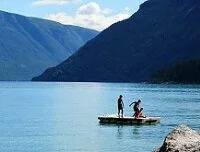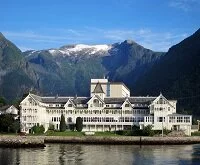Sognefjord Today

Kids on the Lustrafjord
The people who live along Sognefjord today live simple lives much as the people of Norway have lived for centuries (although now with numerous tourist amenities and museums). These people continue to be reliant on the landscape as the waters provide both food and transportation and the mountains nearly isolate the people. Although cruise ships and tourists are now common in the fjord, this tourism is primarily seasonal so the people cling to their historic way of life for much of the year. This is only changing in some areas as museums and other tourist sights are opening up to attract tourists year round.
Aurlandsfjord & Nærøyfjord
 Flåm Railway (Flåmsbana): At the end of the fjord is the town of Flam, which is home to a train line that climbs south through the valley and into the mountains, eventually reaching the Bergen Railway line. If Sognefjord and Bergen are on your route, this is one of the most scenic ways to get from one to the other. For more information visit their website at: www.visitflam.com/flam-railway/.
Flåm Railway (Flåmsbana): At the end of the fjord is the town of Flam, which is home to a train line that climbs south through the valley and into the mountains, eventually reaching the Bergen Railway line. If Sognefjord and Bergen are on your route, this is one of the most scenic ways to get from one to the other. For more information visit their website at: www.visitflam.com/flam-railway/.
 Naeroyfjord (Nærøyfjord) is one of Sognefjord's most impressive arms as it is quite narrow and provides stunning mountains dropping straight into the waters of the fjord. It is ideal for outdoor activities such as kayaking, hiking, or just sitting on a boat as you enjoy the views.
Naeroyfjord (Nærøyfjord) is one of Sognefjord's most impressive arms as it is quite narrow and provides stunning mountains dropping straight into the waters of the fjord. It is ideal for outdoor activities such as kayaking, hiking, or just sitting on a boat as you enjoy the views.
 Undredal Stave Church (Undredal stavkyrkje): This is the smallest still operational church in Norway as it only seats 40 people, but that only adds to its beauty and charm.
Undredal Stave Church (Undredal stavkyrkje): This is the smallest still operational church in Norway as it only seats 40 people, but that only adds to its beauty and charm.
Fjaerlandsfjord & Balestrand
 Bøyabreen Glacier (Bøyabreen): This glacier sits a bit inland from the end of the Fjaerland fjord.
Bøyabreen Glacier (Bøyabreen): This glacier sits a bit inland from the end of the Fjaerland fjord.

Kvikne's Hotel
 Kvikne's Hotel: This historic hotel was built in the Swiss Chalet style in the 1800s and has been a favorite for both royalty and tourists ever since. For more information about the hotel or to stay here, visit their website at: www.kviknes.com.
Kvikne's Hotel: This historic hotel was built in the Swiss Chalet style in the 1800s and has been a favorite for both royalty and tourists ever since. For more information about the hotel or to stay here, visit their website at: www.kviknes.com.
 Kvinnafossen Waterfall (Kvinnafossen): This waterfall is located between the towns of Leikanger and Hella opposite the town of Balestrand.
Kvinnafossen Waterfall (Kvinnafossen): This waterfall is located between the towns of Leikanger and Hella opposite the town of Balestrand.
 Norwegian Glacier Museum & Ulltveit-Moe Climate Center (Norsk Bremuseum): This museum and climate center is located in the town of Fjaerland and has a number of exhibits displaying the nearby glaciers, the landscape, and climate change. For more information visit their website at: www.bre.museum.no.
Norwegian Glacier Museum & Ulltveit-Moe Climate Center (Norsk Bremuseum): This museum and climate center is located in the town of Fjaerland and has a number of exhibits displaying the nearby glaciers, the landscape, and climate change. For more information visit their website at: www.bre.museum.no.
 Sognefjord Aquarium (Sognefjord Akvarium): This aquarium, located in the town of Balestrand, is home to hundreds of fish species and sea life from the Sognefjord. For more information visit their website at: www.kringsja.no/eakvarium.html.
Sognefjord Aquarium (Sognefjord Akvarium): This aquarium, located in the town of Balestrand, is home to hundreds of fish species and sea life from the Sognefjord. For more information visit their website at: www.kringsja.no/eakvarium.html.
Kaupanger
 Kaupanger Stave Church (Kaupanger stavkyrkje): This is one of the many stave churches that line Sognefjord and being located in the town of Kaupanger, is also one of the most accessible. For more information visit their website at: www.stavechurch.com/en/kaupanger/.
Kaupanger Stave Church (Kaupanger stavkyrkje): This is one of the many stave churches that line Sognefjord and being located in the town of Kaupanger, is also one of the most accessible. For more information visit their website at: www.stavechurch.com/en/kaupanger/.
 Sogn Fjord Museum (Sogn Fjordmuseum): This museum, which is associated with the Folk Museum, focuses on the people and culture of the Sognefjord. For more information visit their website at: www.dhs.museum.no/en/sogn-fjord-museum-kaupanger.
Sogn Fjord Museum (Sogn Fjordmuseum): This museum, which is associated with the Folk Museum, focuses on the people and culture of the Sognefjord. For more information visit their website at: www.dhs.museum.no/en/sogn-fjord-museum-kaupanger.
 Sogn Folk Museum (Sogn Folkemuseum): This open air museum, which is associated with the Fjord Museum, is near the town of Kaupanger and demonstrates the farming life and culture of the people of the Sognefjord over the centuries. For more information visit their website at: www.dhs.museum.no/en/open-air-museum-0.
Sogn Folk Museum (Sogn Folkemuseum): This open air museum, which is associated with the Fjord Museum, is near the town of Kaupanger and demonstrates the farming life and culture of the people of the Sognefjord over the centuries. For more information visit their website at: www.dhs.museum.no/en/open-air-museum-0.
Laerdalseyri
 Norwegian Wild Salmon Center (Norsk Villakssenter): This center is exactly what it sounds like, a center educating visitors on salmon in the Norwegian waters, which is located in the town of Laerdalseyri. For more information visit their website at: www.norsk-villakssenter.no (Norwegian only).
Norwegian Wild Salmon Center (Norsk Villakssenter): This center is exactly what it sounds like, a center educating visitors on salmon in the Norwegian waters, which is located in the town of Laerdalseyri. For more information visit their website at: www.norsk-villakssenter.no (Norwegian only).
Lustrafjorden & Luster

Details on Urnes Stave Church
 Feigumfossen Waterfall (Feigumfossen): This waterfall is located near the town of Luster on the Lustrafjorden.
Feigumfossen Waterfall (Feigumfossen): This waterfall is located near the town of Luster on the Lustrafjorden.
 Urnes Stave Church (Urnes stavkyrkje): Urnes Stave Church is the oldest stave church in Norway (built in the 1100s) and is also one of the most impressive. The church is best reached by ferry from the nearby town of Solvorn. For more information visit their website at: www.stavechurch.com/en/urnes/.
Urnes Stave Church (Urnes stavkyrkje): Urnes Stave Church is the oldest stave church in Norway (built in the 1100s) and is also one of the most impressive. The church is best reached by ferry from the nearby town of Solvorn. For more information visit their website at: www.stavechurch.com/en/urnes/.
Vik
 Hopperstad Stave Church (Hopperstad stavkyrkje): This church, in the town of Vik, is one of the most intricately decorated stave churches and is also one of the oldest. For more information visit their website at: www.stavechurch.com/en/.
Hopperstad Stave Church (Hopperstad stavkyrkje): This church, in the town of Vik, is one of the most intricately decorated stave churches and is also one of the oldest. For more information visit their website at: www.stavechurch.com/en/.
Transportation
Sognefjord is somewhat well connected. Boats are easily the best way to see the fjord itself, but car, taxi, and bike also offer great options. Getting to the fjord is a bit more challenging as options take time due to the landscape. There is a small airport along the fjord, but train, boats, and buses seem to be much less expensive and offer numerous options.
 Airport: The only airport in the Sognefjord area is the Haukasen Airport, which is located about 6 miles (10 kilometers) from the town of Kaupanger. There are only a couple flights to and from Oslo and Bergen to this airport; all flights are operated by Wideroe (www.wideroe.no). For its location or directions, see the map below.
Airport: The only airport in the Sognefjord area is the Haukasen Airport, which is located about 6 miles (10 kilometers) from the town of Kaupanger. There are only a couple flights to and from Oslo and Bergen to this airport; all flights are operated by Wideroe (www.wideroe.no). For its location or directions, see the map below.
 Train Station: The only train station along the Sognefjord is the station in Flam (mentioned above). For train times and schedules, the website is: www.nsb.no. For its location or directions, see the map below.
Train Station: The only train station along the Sognefjord is the station in Flam (mentioned above). For train times and schedules, the website is: www.nsb.no. For its location or directions, see the map below.
Bus Station: There are numerous private bus companies that service towns in Sognefjord, but the towns and origins of these bus services vary by the town's location and geographical obstacles.
Local Transportation: There are numerous ways to get around Sognefjord, but the most comfortable and scenic is by boat. Nearly every town has boat services or tours that let you explore other regions for a day trip. The region is also accessible by road, but the landscape often times means long journeys for the short distances traveled.
Official Websites
Region of Sognefjord: www.sognefjord.no
Kingdom of Norway: www.visitnorway.com
Map & Directions